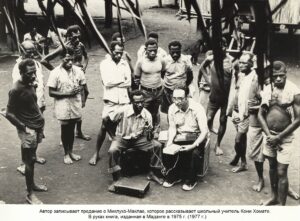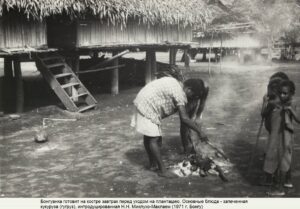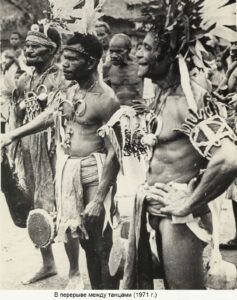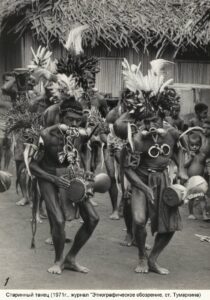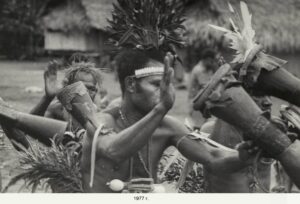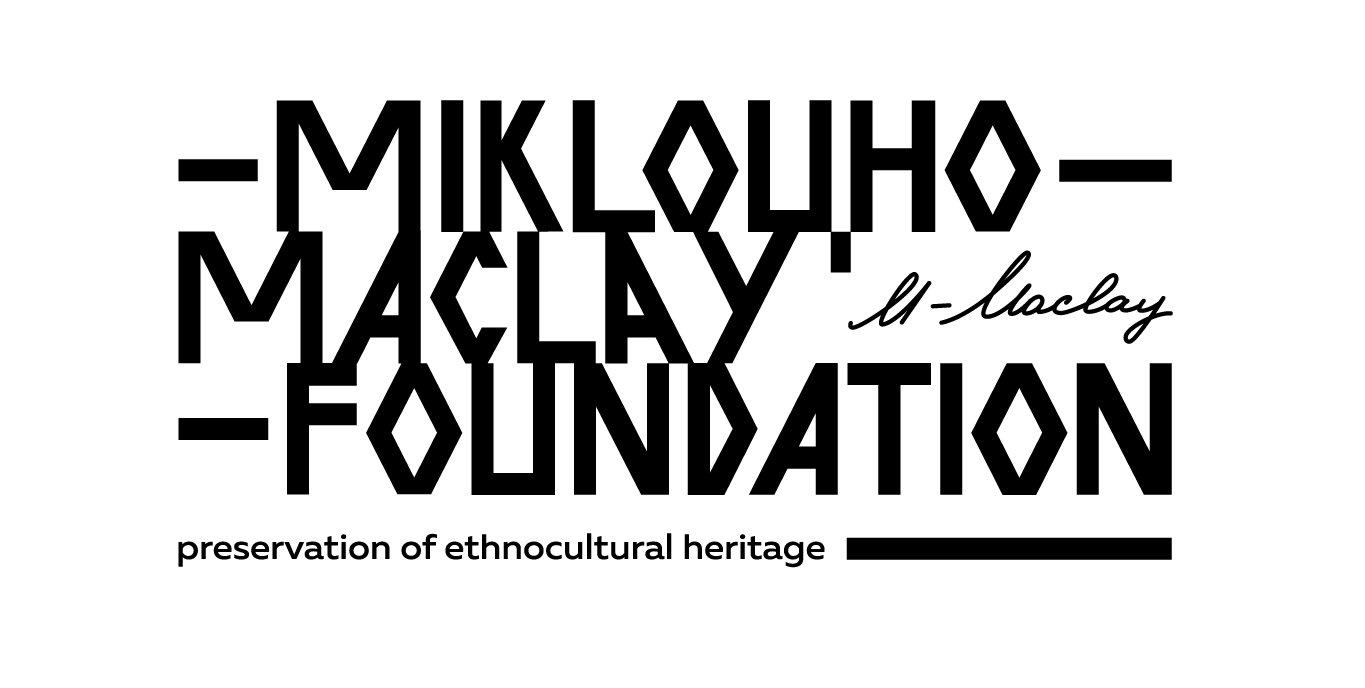Soviet Expeditions to Oceania in 1971 and 1977.
Ethnographic research in the region after century-long hiatus
The field work of Soviet ethnographers on the islands of Oceania in the 1970s was a new stage in the development of Russian ethno-oceanistics. The rich ethnographic material collected during the expeditions helped to take a new look at a number of scientific issues.
In the late XIX - early XX centuries, expeditions of Russian scientists to Oceania ceased. But already in the mid-1920s the USSR began to develop plans for the continuation of scientific research of the peoples of Oceania. However, due to political problems and, later, the outbreak of the Great Patriotic War, all work in this direction was halted. Only in the first after-war years the vessel "Vityaz" at the disposal of the USSR Academy of Sciences began to make regular voyages to the Pacific Ocean, first to the northern latitudes and then to the southern ones. But these expedition voyages were mainly oceanological in nature. Nevertheless, "Vityaz" visited the Maclay Coast twice. The first time, in April 1966, it stayed in Madang for five days to refuel and replenish fresh water and provisions. In December 1970, "Vityaz" again visited the Maclay Coast and anchored for a few hours at Port Constantine, not far from Bongu village, which N. N. Miklouho-Maclay had visited three times. The expedition members erected an obelisk dedicated to the stay of the famous traveler in these places. The next year Soviet ethnographers again found themselves in the Maclay Coast, and in other areas of Oceania.
The sixth voyage of the research vessel "Dmitry Mendeleev" in 1971 was dedicated to the double anniversary: the centenary of the first N. N. Miklouho-Maclay's first visit to Bongu and the 125th anniversary of his birth. The ethnographic expedition team consisted of eight scientists: D. D. Tumarkin (team leader), V. N. Basilov, N. A. Butinov, M. V. Kryukov, N. M. Girenko, O. M. Pavlovsky, B. N. Putilov, and I. M. Meliksetova. In addition, V. G. Ryklin and A. N. Popov were as documentary filmmakers. The captain of the ship was M. V. Sobolevsky, and the expedition chief was oceanologist A. A. Aksyonov.
The expedition left Vladivostok on 17 June 1971 for the southern latitudes. On 27 June, the ship called in for four days at Singapore and then set a course for the coast of New Guinea. On 8 July, "Dmitry Mendeleev" called at Madang, and on 9 July anchored at Port Constantine. The ethnographic team went ashore for field work in Bongu village, but other members of the expedition and the ship's crew were forbidden to visit the village without special permission, so as not to interfere with the work of the ethnographers.
In the course of four days of fieldwork, the Soviet scientists found that the Bonguans retained many of the main features of their distinctive culture, while elements of Western culture were superimposed on the traditional way of life. So, the basis of the economy remained slash-and-burn agriculture and fishing. Agricultural tools were the same (wooden stake – sab and wooden spade – udya sab), widely spread mats made of palm leaves, dishes of wood and coconut shells, as well as clay pots, which, as in the times of Maclay, the Bonguans purchased in the coastal village of Bili Bili. Bonguans went out fishing on traditional dugout boats with outriggers (balance beam), but they used iron fishing hooks, and the tips of bamboo spears were made from nails. The locals used metal axes, saws and knives, they wore European-style clothes made of purchased fabrics, but still walked barefoot, they used kerosene lamps (when they had enough money for kerosene). The elder of the village had a transistor radio. The main source of cash income was the sale of copra to Australian buyers. Bonguans adopted Christianity only superficially and intricately intertwined it with their traditional beliefs. There were also adherents of the Cargo Cult in the village. The memory of Maclay among the Bonguans was preserved and passed down from generation to generation, as the legends about him became an important part of local folklore and religious beliefs. On the last day of the ethnographers' stay in the village, the Papuans (the natives) arranged a grand celebration in their honor with songs, dances and pantomimes. Other members of the team and crew members joined this feast.
After the Maclay Coast, the expedition team visited the Micronesian island of Nauru and then headed for the Vanuatu Archipelago. On Efate Island, members of the expedition met with the famous artist of Russian origin, N. N. Mishutushkin, and his companion, the Polynesian artist A. Pilioko. After Vanuatu, "Dmitry Mendeleev" visited Sydney, and then New Caledonia, Fiji, Samoa, Tuvalu and Kiribati. On the way back the ship stopped in Tokyo, and on October 13 arrived in Vladivostok. The entire expedition lasted almost four months. Soviet ethnographers collected a huge amount of material on the culture and customs of the inhabitants of the Maclay Coast. These results were presented in several monographs and a number of articles published in various scientific journals. In 1975, the collective monograph "On the Maclay Coast (Ethnographic essays)", related to the economic structure, material culture, languages, and the anthropological type of the inhabitants of the village of Bongu, was released.
In 1977, another expedition voyage of the vessel "Dmitry Mendeleev" to Oceania took place. This time the ethnographic team included five members: D. D. Tumarkin (team leader), V. N. Basilov, I. M. Meliksetova, E. N. Kalshchikov, V. N. Shamshurov. Like the previous time, documentary filmmakers V. G. Ryklin and A. N. Popov joined the team. In addition, artists M. L. Plakhova and B. V. Alekseev (a married couple). The captain of the vessel was A. S. Svitailo, and the expedition chief was hydrobiologist L. A. Ponomaryova.
Before getting to the Maclay Coast, the expedition team visited Port Moresby, the capital of the Independent State of Papua New Guinea (gained Independence in 1975). Then "Dmitry Mendeleev" headed for the Astrolabe Bay, along the way visiting the islands of Trobriand, New Britain, New Ireland, Lavongai, Admiralty, Hermit, etc.
On February 11, the ship approached Madang, where it stood for two days to refuel and replenish water and food supplies. On February 13, the ethnographic group went ashore at Port Constantine and headed for Bongu. This time, the scientists spent five days in the village, conducting field work in different directions.
While researching, a significant increase in property differentiation among Bonguans was revealed in comparison to 1971. In the field of agriculture, D.D. Tumarkin noticed a very important element: irrigation channels passing between garden plots. Through these ditches, rainwater, flowing down the slope of the hill, accumulated in a small pond. The Bonguans said that these irrigation ditches had existed here since time immemorial. This primitive irrigation system, which is not typical for the inhabitants of the northeastern part of New Guinea, was not mentioned in Miklouho-Maclay's records, and in 1971 scientists did not find it, because they did not inspect the vegetable gardens. A survey made in 10 houses showed that the residents of Bongu had more purchased things — clothes, dishes, etc. Electric flashlights were commonly used in everyday life, there were more than a dozen portable radios.
Using the radios Bonguans regularly listened to the news transmitted from the capital Port Moresby in Tok Pisin, educational programs, a variety of music from traditional Oceanic songs and melodies to modern Western ones, such as jazz and hard rock. But at the same time, Bonguans continued to widely use traditional wooden and bamboo vessels, clay pots and mats made of palm leaves. The houses retained their former shape and were built exclusively of local materials. It should be noted that at the end of the XIX century, as a result of land expropriations by the German colonial authorities, the villagers of Gorendu and Gumbu were forced to move to Bongu, and during the Soviet expeditions, this village was still the only settlement for the Bongu ethnic group (Gorendu and Gumbu villages, and the small village of Ileg were newly built and settled in the 1990s). It should be noted that in the six years that have passed, the memory of N. N. Miklouho-Maclay has not only not weakened, but has also gained new forms. On the last day of the ethnographers' stay in the village, the Bonguans again arranged a big feast with songs, dances and pantomimes for all members of the expedition team.
Leaving Bongu, "Dmitry Mendeleev" headed for the city of Lae, the capital of Morobe Province. Here the ship stayed for two days, as a group of Soviet geologists and botanists was expected to arrive, who set out from Bongu into the mountains with the local guides in order to go out to the sea by the mountain gorge in the vicinity of Lae. The team successfully completed this scientific excursion and arrived in Lae at the appointed time with interesting plant and rock specimens. After leaving Papua New Guinea, the ship called in at Brisbane and then headed for the islands of Fiji and Tonga. On the Tonga Islands, the members of the Soviet expedition had a memorable meeting with the Tongan King Tāufaʻāhau Tupou IV (1918-2006). He had an interesting hobby - collecting Russian balalaikas. Knowing about it, the chief of the ethnographic team D. Tumarkin bought in Moscow a concert balalaika and during the audience with the Tongan King presented him a beautiful gift which he was pleased with. During the meeting Tāufaʻāhau Tupou IV told the Soviet guests that he dreamed of visiting the Soviet Union and crossing the entire country by the Trans-Siberian railroad, to visit Moscow and Leningrad. He also told them that he had read Russian classics in English, especially he liked Chekhov's stories. After visiting the Tonga Islands, "Dmitry Mendeleev" set sail for Vladivostok. On the way it stopped in Singapore for refueling. The scientific results of this expedition were also very important. Ethnographers published many articles on various cultural aspects related to the islands they visited.
Список литературы
Бутинов Н. А. Путь к Берегу Маклая. Хабаровск, 1975.
Крюков В. М. Этот таинственный остров Эроманга. М., 1989.
Меликсетова И. М. Встреча с Океанией 70-х годов. М., 1976.
На Берегу Маклая (Этнографические очерки). М., 1975.



